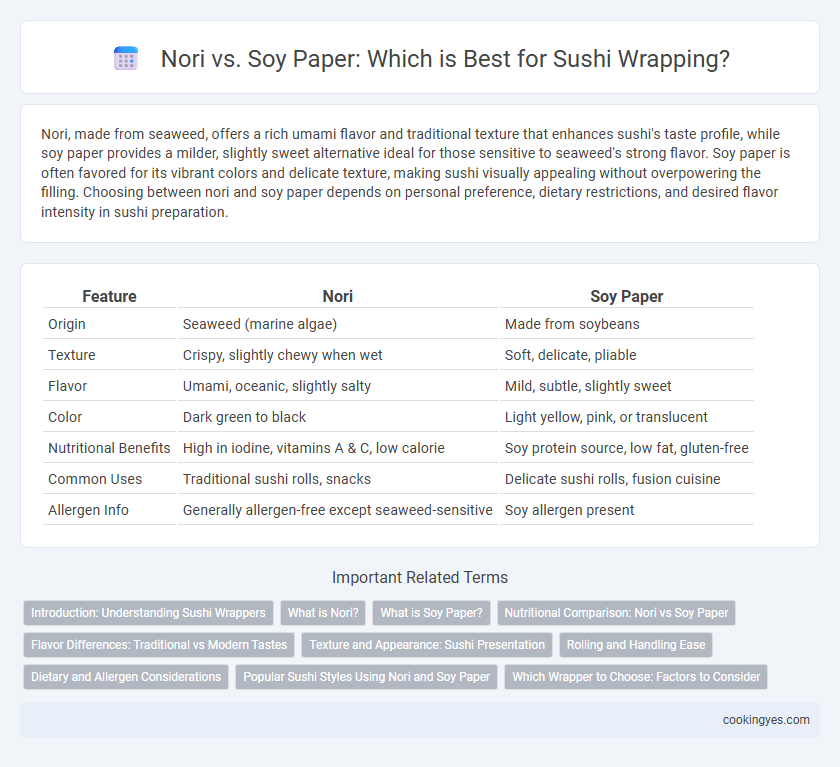Nori, made from seaweed, offers a rich umami flavor and traditional texture that enhances sushi's taste profile, while soy paper provides a milder, slightly sweet alternative ideal for those sensitive to seaweed's strong flavor. Soy paper is often favored for its vibrant colors and delicate texture, making sushi visually appealing without overpowering the filling. Choosing between nori and soy paper depends on personal preference, dietary restrictions, and desired flavor intensity in sushi preparation.
Table of Comparison
| Feature | Nori | Soy Paper |
|---|---|---|
| Origin | Seaweed (marine algae) | Made from soybeans |
| Texture | Crispy, slightly chewy when wet | Soft, delicate, pliable |
| Flavor | Umami, oceanic, slightly salty | Mild, subtle, slightly sweet |
| Color | Dark green to black | Light yellow, pink, or translucent |
| Nutritional Benefits | High in iodine, vitamins A & C, low calorie | Soy protein source, low fat, gluten-free |
| Common Uses | Traditional sushi rolls, snacks | Delicate sushi rolls, fusion cuisine |
| Allergen Info | Generally allergen-free except seaweed-sensitive | Soy allergen present |
Introduction: Understanding Sushi Wrappers
Nori and soy paper serve as popular sushi wrappers, each offering distinct textures and flavors that enhance the sushi experience. Nori, made from roasted seaweed, provides a traditional umami taste rich in nutrients like iodine and vitamins A and C. Soy paper, crafted from soy protein, offers a milder flavor and softer texture, making it a preferred option for those sensitive to seaweed or seeking a visually colorful presentation.
What is Nori?
Nori is a type of edible seaweed commonly used in traditional sushi wrapping, prized for its rich umami flavor and slightly crispy texture when toasted. It is made from red algae species, primarily Porphyra, which are harvested, shredded, and dried into thin sheets. Nori is rich in nutrients such as iodine, vitamins A and C, and protein, making it both a flavorful and nutritious choice for sushi rolls.
What is Soy Paper?
Soy paper, also known as mamenori, is a thin, translucent wrapper made from compressed soybeans, often used as a vegan alternative to traditional seaweed (nori) in sushi rolls. It offers a mild flavor and delicate texture, enhancing the visual appeal of sushi with its colorful and smooth appearance. Soy paper is popular for those with seaweed allergies or for creating sushi that highlights other ingredients without overpowering them.
Nutritional Comparison: Nori vs Soy Paper
Nori, a seaweed-based sushi wrap, is rich in iodine, vitamins A and C, and offers a high fiber content, making it beneficial for thyroid health and digestion. Soy paper, made from soybeans, provides a lower calorie and fat alternative with moderate protein and is often favored for those with seaweed allergies. Comparing the two, nori generally delivers more micronutrients and antioxidants, while soy paper offers a mild flavor with a softer texture and is lower in sodium.
Flavor Differences: Traditional vs Modern Tastes
Nori offers a robust, umami-rich flavor that enhances the traditional sushi experience with its slightly salty and oceanic taste. Soy paper provides a milder, more neutral profile ideal for those seeking a lighter, less intense wrapping that allows the filling's flavors to stand out. Choosing between nori and soy paper depends on whether one prefers the bold, savory depth of classic sushi or the subtle, contemporary taste favored in modern sushi rolls.
Texture and Appearance: Sushi Presentation
Nori provides a crisp, slightly chewy texture that enhances the traditional sushi experience while offering a deep, savory umami flavor and a dark green to almost black appearance that highlights the vibrant colors of the fillings. Soy paper, in contrast, offers a smoother, softer texture with a subtle sweetness and comes in a variety of pastel colors, contributing to a more delicate and visually diverse sushi presentation. Choosing between nori and soy paper significantly impacts both the tactile sensation and the aesthetic appeal of the sushi, influencing the overall dining experience.
Rolling and Handling Ease
Nori, made from roasted seaweed, provides a firm texture that holds sushi rolls tightly, enabling easier handling and precise slicing. Soy paper offers a softer, more pliable alternative, ideal for delicate ingredients but can be more challenging to roll without tearing. Both options impact the sushi-making experience by influencing the firmness and stability of the roll during preparation.
Dietary and Allergen Considerations
Nori, made from seaweed, is rich in vitamins A, C, and iodine, making it a nutritious choice for sushi wrapping, but it may trigger shellfish or iodine allergies in sensitive individuals. Soy paper offers a hypoallergenic alternative suitable for people with seaweed allergies or those seeking a soy-based, gluten-free option, though it may not provide the same nutrient density as nori. Selecting between nori and soy paper depends on individual dietary restrictions and allergen sensitivities, ensuring a safe and inclusive sushi experience.
Popular Sushi Styles Using Nori and Soy Paper
Popular sushi styles using nori include traditional maki rolls, such as tuna and cucumber rolls, where the nori provides a robust umami flavor and crisp texture. Soy paper is often favored for delicate sushi varieties like rainbow rolls or vegetarian sushi, offering a mild taste and vibrant color without overpowering the fillings. Both wrappers serve unique culinary roles, enhancing the presentation and taste profiles tailored to different types of sushi.
Which Wrapper to Choose: Factors to Consider
Choosing between nori and soy paper for sushi wrapping depends on flavor preference, dietary restrictions, and texture. Nori, a traditional seaweed wrap, offers a salty, umami taste and is rich in nutrients like iodine and vitamins A and C. Soy paper provides a milder taste and is ideal for those with seaweed allergies, featuring a softer texture and a slightly sweet flavor that complements delicate sushi fillings.
Nori vs Soy Paper for Sushi Wrapping Infographic

 cookingyes.com
cookingyes.com